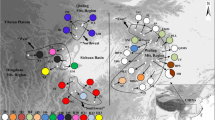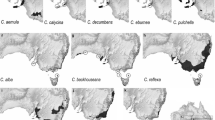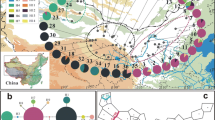Abstract
Datisca (Datiscaceae) is a ditypic genus with an intercontinentally disjunct distribution. Chloroplast DNA restriction site data was obtained from 23 populations and four 10–20 year old herbarium specimens ofD. glomerata and three populations ofD. cannabina from throughout their geographic ranges in western North America and southwest-central Asia, respectively. InD. glomerata, plastome diversity is partitioned geographically. All populations from southern California have a common plastome, while most populations north of this region share a relatively divergent plastome (0.49% sequence divergence). Likewise, these plastomes are highly divergent (0.87% mean sequence divergence) from those found inD. cannabina. Biogeographic processes dating to the Pleistocene and Late Miocene may be responsible for these intra- and interspecific patterns of chloroplast DNA divergence.
Similar content being viewed by others
References
Arnold, M. L., Buckner, C. M., Robinson, J. J., 1991: Pollen mediated introgression and hybrid speciation in Louisiana irises. — Proc. Natl. Acad. Sci. U.S.A.88: 1398–1402.
Beckstrom-Sternberg, S. M., Rieseberg, L. H., Doan, K., 1991: Gene lineage analysis in populations ofHelianthus niveus andH. petiolaris (Asteraceae). — Pl. Syst. Evol.175: 125–138.
Birky, C. W., 1991: Evolution and population genetics of organelle genes: mechanisms and models. — InSelander, R. K., Clark, A. G., Whittam, T. S., (Eds.): Evolution at the molecular level, pp. 112–134. — Sunderland, Mass.: Sinauer.
—, 1983: An approach to population and evolutionary genetic theory for genes in mitochondria and chloroplasts, and some results. — Genetics103: 513–527.
Boesewinkel, F. D., 1984: Ovule and seed structure inDatiscaceae. — Acta Bot. Neerl.33: 419–430.
Bohm, B. A., 1987: Intraspecific flavonoid variation. — Bot. Rev. (Lancaster)53: 197–280.
—, 1988: Flavonoid systematics of theDatiscaceae. — Biochem. Syst. Ecol.16: 151–155.
Crawford, D. J., Lee, N. S., Stuessy, T. F., 1991: Plant species disjunctions: perspectives from molecular data. — Aliso (in press).
Davidson, C., 1973: An anatomical and morphological study ofDatiscaceae. — Aliso8: 49–110.
—, 1976: Anatomy of xylem and phloem of theDatiscaceae. — Sci. Contrib. Nat. Hist. Mus. Los Angeles County280: 1–28.
Doyle, J. J., Doyle, J. L., 1987: A rapid DNA isolation procedure for small quantities of fresh leaf tissue. — Phytochem. Bull.19: 11–15.
Felsenstein, J., 1991: PHYLIP, phylogeny inference package, version 3.4. — Seattle: University of Washington.
Fitch, W. M., Margoliash, E., 1967: Construction of phylogenetic trees. — Science155: 279–284.
Haraldsen, K. B., Odegaard, M., Nordal, I., 1991: Variation in the amphi-Atlantic plantVahlodea atropurpurea (Poaceae). — J. Biogeography18: 311–320.
Hoey, M. T., Parks, C. R., 1991: Intercontinental patterns of genetic divergence in Asian, North American, and Turkish species ofLiquidambar (Hamamelidaceae). — Amer. J. Bot.78 (in press).
Liston, A., Rieseberg, L. H., Elias, T. S., 1989a: Genetic similarity is high between intercontinental disjunct species ofSenecio. — Amer. J. Bot.76: 383–388.
—, —, —, 1989b: Morphological stasis and molecular divergence in the intercontinental disjunct genusDatisca (Datiscaceae). — Aliso12: 525–542.
—, —, —, 1990: Functional androdioecy in the flowering plantDatisca glomerata. — Nature343: 641–642.
Nei, M., 1972: Genetic distance between populations. — Amer. Naturalist106: 283–292.
—, 1983: Maximum likelihood estimation of the number of nucleotide substitutions from restriction sites data. — Genetics105: 207–217.
Ogihara, Y., Terachi, T., Sasakuma, T., 1991: Molecular analysis of the hot spot region related to length mutations in wheat chloroplast DNAs. I. Nucleotide divergence of genes and intergenic spacer regions located in the hot spot region. — Genetics129: 873–884.
Palmer, J. D., 1982: Physical and gene mapping of chloroplast DNA fromAtriplex triangularis andCucumis sativa. — Nucleic Acids Res.10: 1593–1605.
—, 1986: Isolation and structural analysis of chloroplast DNA. — Methods Enzymol.118: 167–186.
—, 1991: Plastid chromosomes: structure and evolution. — InBogorad, L., Vasil, I. K., (Eds.): Cell culture and somatic cell genetics of plants, pp. 5–53. — San Diego: Academic Press.
—, 1988: Phylogenetic analysis of chloroplast DNA variation. — Ann. Missouri Bot. Gard.75: 1180–1218.
Parks, C. R., Wendel, J. F., 1990: Molecular divergence between Asian and North American species ofLiriodendron (Magnoliaceae) with implications for interpretation of fossil floras. — Amer. J. Bot.77: 1243–1256.
Raven, P. H., Axelrod, D. I., 1978: Origin and relationships of the California flora. — Univ. Calif. Publ. Bot.72: 1–134.
Rieseberg, L. H., Brunsfeld, S. J., 1991: Molecular evidence and plant introgression. — InSoltis, P. S., Soltis, D. E., Doyle, J. J., (Eds.): Molecular systematics of plants, pp. 151–176. — New York: Chapman & Hall.
—, 1991: Phylogenetic consequences of cytoplasmic gene flow in plants. — Evol. Trends Plants5: 65–84.
-Hanson, M., Philbrick, C. T., 1992: Androdioecy is derived from dioecy inDatiscaceae: Evidence from restriction site mapping of PCR-amplified chloroplast DNA fragments. — Syst. Bot.17 (in press).
Sasaki, Y., Nagano, Y., Morioka, S., Ishikawa, H., Matsuno, R., 1989: A chloroplast gene encoding a protein with one zinc finger. — Nucleic Acids Res.17: 6217–6228.
Scherer, S., 1990: The protein molecular clock—time for reevaluation. — Evol. Biol.24: 83–106.
Shinozaki, K., Ohme, M., Tanaka, M., Wakasugi, T., Hayashida, N., Matsubayashi, T., Zaita, N., Chunwongse, J., Obokata, J., Yamaguchi-Shinozaki, K., Ohto, C., Torazawa, K., Meng, B.-Y., Sugita, M., Deno, H., Kamagoshira, T., Yamada, K., Kusuda, J., Takaiwa, F., Kato, A., Tohdoh, N., Shimada, H., Suguira, M., 1986: The complete nucleotide sequence of the tobacco chloroplast genome: its organization and expression. — EMBO J.5: 2043–2049.
Sinotô, Y., 1929: Chromosome studies in some dioecious plants, with special reference to allosomes. — Cytologia1: 109–191.
Snow, R., 1959: Chromosome numbers of California plants, with notes on some cases of cytological interest. — Madroño15: 81–89.
Soltis, D. E., Mayer, M. S., Soltis, P. S., Edgerton, M., 1991b: Chloroplast-DNA variation inTellima grandiflora (Saxifragaceae). — Amer. J. Bot.78: 1379–1390.
—, 1991a: Intraspecific chloroplast DNA variation: systematic and phylogenetic implications. — InSoltis, P. S., Soltis, D. E., Doyle, J. J., (Eds.): Molecular systematics of plants, pp. 117–150. — New York: Chapman & Hall.
—, —, —, —, 1989: Chloroplast DNA variation in a wild plant,Tolmiea menziesii. — Genetics121: 819–826.
Swofford, D. L., 1991: PAUP: Phylogenetic analysis using parsimony, Version 3.0. Computer program distributed by the Illinois Natural History Survey. — Champaign, IL.
Sytsma, K. J., Gottlieb, L. D., 1986: Chloroplast DNA evolution and phylogenetic relationships inClarkia sect.Peripetasma (Onagraceae). — Evolution40: 1248–1261.
—, 1991: The use of chloroplast DNA to assess biogeography and evolution of morphology, breeding systems, flavonoids inFuchsia sect.Skinnera (Onagraceae). — Syst. Bot.16: 257–269.
Vogelmann, J. E., Gastony, G. J., 1987: Electrophoretic enzyme analysis of North American and eastern Asian populations ofAgastache sect.Agastache (Labiatae). — Amer. J. Bot.74: 385–393.
Wendel, J. F., Percival, A. E., 1990: Molecular divergence in the Galapagos Islands—Baja California species pair,Gossypium klotzschianum Anderss. andG. davidsonii Kell. — Pl. Syst. Evol.171: 99–115.
Wolfe, K. H., Li, W. H., Sharp, P. M., 1987: Rates of nucleotide substitution vary greatly among plant mitochondrial, chloroplast, and nuclear DNAs. — Proc. Natl. Acad. Sci. U.S.A.84: 9054–9058.
Zurawski, G., Clegg, M. T., 1987: Evolution of higher-plant chloroplast DNA-encoded genes: implications for structure-function and phylogenetic studies. — Ann. Rev. Pl. Physiol.38: 391–418.
Author information
Authors and Affiliations
Rights and permissions
About this article
Cite this article
Liston, A., Rieseberg, L.H. & Hanson, M.A. Geographic partitioning of chloroplast DNA variation in the genusDatisca (Datiscaceae). Pl Syst Evol 181, 121–132 (1992). https://doi.org/10.1007/BF00937591
Received:
Revised:
Accepted:
Issue Date:
DOI: https://doi.org/10.1007/BF00937591




